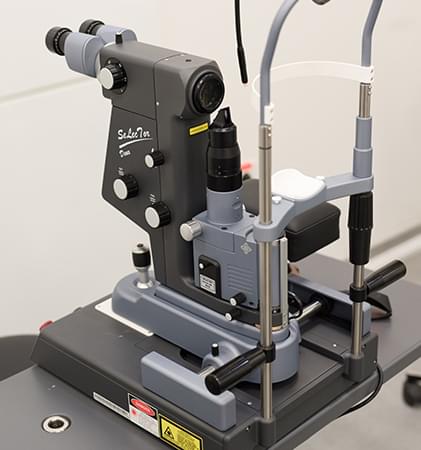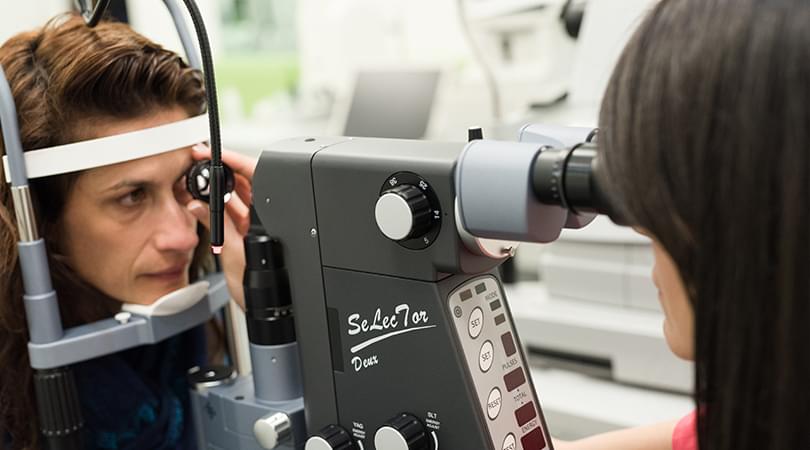Glaucoma
What is glaucoma?
Glaucoma, along with cataracts, is one of the main causes of blindness worldwide. The term glaucoma is a broad term and includes a group of degenerative diseases that are manifested by characteristic changes in the visual field. It can cause damage to the optic nerve, which carries the visual information from the eye to the brain.
In many cases, the damage to the optic nerve is caused by increased pressure in the eye, also known as intraocular pressure (IOP). This pressure and the tolerance of the optic nerve to it is strictly individual, and the eye pressure should not be identified with glaucoma.
Millions of people around the world suffer from glaucoma. In most cases, the process occurs slowly and imperceptibly, without pain or special symptoms. As the condition progresses, significant defects appear in the visual field. If left unattended and without control, the disease can lead to complete blindness. That is why glaucoma is particularly dangerous and insidious. The disease causes irreversible damage to the eyesight.

There are predisposing factors for the development of glaucoma. It occurs more frequently after the age of 45 years, in people with diabetes, cardiovascular disease and family history. The early detection of glaucoma is a critical for its treatment. Therefore, the people over 40 years of age must measure their intraocular pressure when they visit ophthalmologist. The main objective of the therapy is to reduce the intraocular pressure and improve blood supply to the eye. The idea is to stop the progression of the process, stabilize the visual field and, of course, to preserve the patient's vision. This can be achieved by eye drops, laser treatment or surgery.
Types of glaucoma
Primary glaucoma
The primary (also known as chronic) glaucoma, is usually observed in elderly people and is the most common type of glaucoma. It is caused by relative obstruction of the eye ducts, as a result of which the intraocular pressure increases. It runs slowly (for years), with rare exceptions it is without symptoms. The primary glaucoma is open-angle and closed-angle.
Symptoms of primary open-angle glaucoma:
- most people have no symptoms until they begin to experience loss of vision
- gradual loss of peripheral (lateral) vision
Symptoms of primary closed-angle glaucoma:
- strong pain
- reddening of the eyes
Secondary glaucoma
Glaucoma is secondary when it is not caused by the natural aging. It is usually accompanied by other diseases. With pronounced symptoms and often with rapid development. It may be closed-angle, open-angled, pigmented, etc.
Congenital glaucoma is when it occurs immediately after birth. The symptoms are usually noticed when the child is several months old:
- opacity in the anterior part of the eye
- increase of the size of one or both eyes
- red eyes
- sensitivity to light
Treatment and prevention of glaucoma
The damage to the patient's vision caused by glaucoma is generally irreversible and no treatment is known to date. Glaucoma could be slowed or kept from further development by eye drops, medications, and laser or surgical interventions. In any type of glaucoma, periodic examinations are required to prevent loss of vision, because the process is dynamic and you may need a periodic adjustment in the therapy. Treatment of glaucoma is focused on reducing intraocular pressure to a value that will not cause further damage to the optic nerve.
The doctors of Eye Hospital Luxor have years of experience in the prevention and treatment of glaucoma. Dozens of patients visit our hospital every month for consultations and treatment of glaucoma.
Medications
The open-angle glaucoma is most commonly treated with eye drops, which reduce the intraocular pressure to the desired values. These drugs decrease the intraocular pressure by reducing the production of intraocular fluid or by enhancing its drainage. In many cases, it is necessary to combine several types of eye drops, which may make it difficult for patients. The antiglaucoma drops may also have side effects – such as a burning sensation in the eyes or redness. In order to reduce the side effects on the eye structures, many pharmaceutical companies have developed drops without preservatives.
In closed-angle glaucoma, drops are used that shrink the pupil and thus help to detect the chamber angle - the primary site for drainage of the intraocular fluid. In some cases, tablets or intravenous medication may be required to normalize the intraocular pressure.
Laser treatment - Selective Laser Trabeculoplasty
The Selective Laser Trabeculoplasty (SLT) is one of the most advanced methods for treating open-angle glaucoma. The aim is to improve the drainage of the intraocular fluid and, accordingly, reduce the intraocular pressure. The laser treats the trabecular meshwork – this is the area in the eye through which the intraocular fluid is drained. The laser procedure is bloodless and lasts about 10 minutes for one eye. It must be repeated at some time intervals (months to year) when an undesirable change (increase) in the intraocular pressure occurs.
The laser therapy is appropriate for newly discovered cases of glaucoma, as well as for people who have difficulty in properly and regularly applying anti-glaucoma drops, or want to reduce the number of medications they apply to their eyes. According to the latest publications, the selective laser trabeculoplasty can also be successfully applied in cases of closed-angle glaucoma.
LIGHTLas SLT Deux
Eye Hospital Luxor has the most advanced and extremely precision laser for selective trabeculoplasty LIGHTLas SLT Deux.
The American company LightMed, the manufacturer of the laser system, is renowned worldwide for the high quality of its ophthalmology equipment.
Main technical advantages:
- premium Crystal-Q Switch Laser Cavity
- an integrated biomicroscopy system
- 5 positions to change the size of the image
- wide-angle optics
- self-calibrating system


Testimonials
Patient reviews after selective laser trabeculoplasty

Nencho Tonchev
"Patients should not worry. It is not painful and there are no negative side effects."

Dobrin Dobrev
"I advise everyone with similar eye problems to take advantage of the laser therapy."
Minimally invasive glaucoma surgery XEN Gel Stent
For many people, surgery can be the best treatment for their glaucoma. There are several types of glaucoma surgery. The minimally invasive glaucoma surgery is introduction of glaucoma implant without removing part of the eye structures, as in classical surgery. The implant (Xen Gel Stent) is a 6 mm long collagen tube with a hair-size opening that takes part of the intraocular fluid outside the eye. The XEN Gel Stent is placed in the eye of the patient by means of two micro-openings, the operation is sutureless, minimally traumatic and very fast - about 10 minutes. When placed in the right place, a permanent decrease of the intraocular pressure can be achieved and the use of anti-glaucoma medications can be reduced or, in some cases even stopped.
The procedure is especially suitable for people who have a dynamic lifestyle and cannot apply their eye drops regularly, which in turn leads to poor glaucoma control. Because of the fewer risks compared to classical surgery, it is preferred as the first choice for operative glaucoma treatment. The need for periodic follow-up checkups with intraocular pressure measurement after surgery remains! In rare cases, after some time additional medication may be necessary to be injected around the implant to improve its function.
The development of implants that are as close as possible to the structure of human tissues and combining them with minimally invasive surgery promises a new step forward in the modern surgical treatment of glaucoma.
Classical surgery – Trabeculectomy
Sometimes, when there is a rapid loss of vision or when the medications, the laser treatment or the minimally invasive glaucoma surgery fail to lower the intraocular pressure sufficiently, classical surgery is the best solution. The surgeon uses very fine tools to remove a small piece of the eye wall, leaving a tiny hole. The fluids can flow through the hole and be absorbed by the blood stream, which leads to reduction of the intraocular pressure. In some cases, the surgeon may place an implant in the shape of sponge, a tube or a valve for more precise regulation of the drainage of the intraocular fluid.
The recovery period after classical glaucoma surgery is usually short. The ophthalmologist may advise you to refrain from heavy physical effots, straining or driving for some time after surgery to avoid complications. As with any surgical intervention, patients should be aware of the risks associated with glaucoma surgery. Complications are rare, but include infection, bleeding, undesirable changes in the intraocular pressure and, in some cases, loss of vision. Sometimes, a surgical procedure does not effectively stop the progress of glaucoma. In these cases, a second operation may be performed and the medication therapy continued.